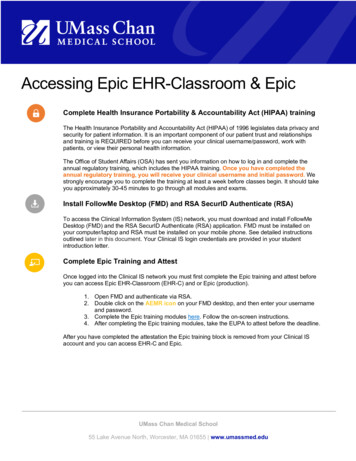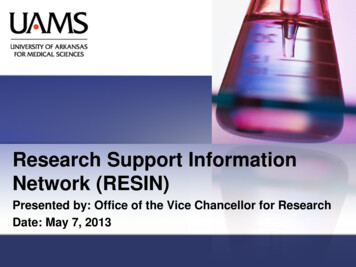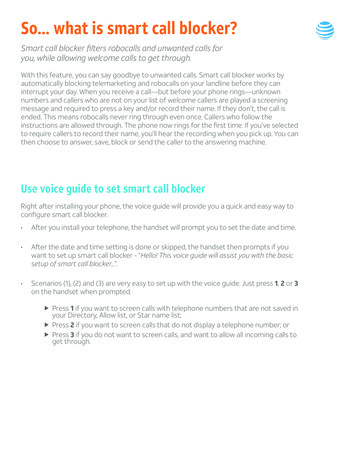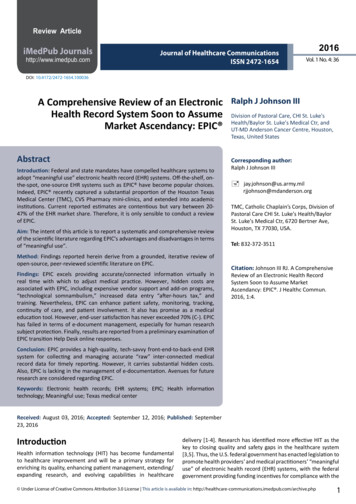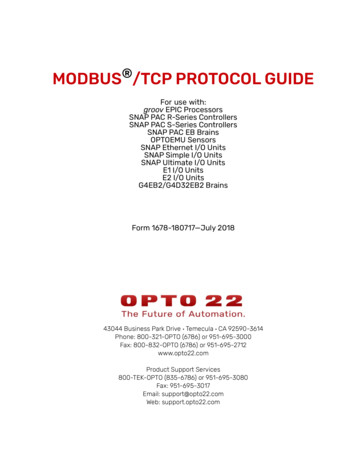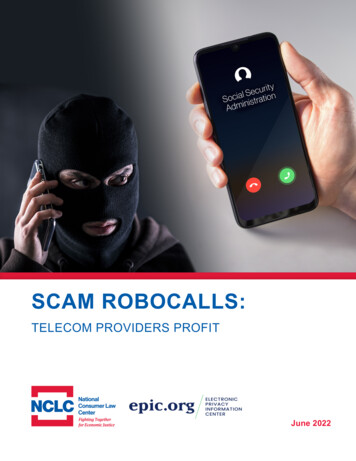
Transcription
SCAM ROBOCALLS:TELECOM PROVIDERS PROFITJune 2022
ABOUT THE NATIONALCONSUMER LAW CENTER Copyright 2022, National Consumer Law Center, Inc. andElectronic Privacy Information Center. All rights reserved.Since 1969, the nonprofit NationalConsumer Law Center (NCLC ) hasused its expertise in consumer law andenergy policy to work for consumerjustice and economic security forlow-income and other disadvantagedpeople in the United States. NCLC’sexpertise includes policy analysis andadvocacy; consumer law and energypublications; litigation; expert witnessservices; and training and advice foradvocates. NCLC works with nonprofitand legal services organizations, privateattorneys, policymakers, and federaland state government and courts acrossthe nation to stop exploitative practices,help financially stressed familiesbuild and retain wealth, and advanceeconomic fairness.ABOUT THE AUTHORSNCLC.ORGABOUT THE ELECTRONICPRIVACY INFORMATIONCENTERElectronic Privacy Information Center(EPIC) is a public interest researchcenter in Washington, D.C., focusedon emerging privacy and technologyissues. Since 1994, EPIC has workedat the intersection of policy, advocacy,and litigation. EPIC litigates cases onemerging privacy issues, provides expertadvice to policymakers, lawmakers,courts and litigators, and facilitatesdialogue between advocates, experts,and decisionmakers. EPIC has workedfor strong consumer protectionsagainst unwanted and illegal callsthrough numerous amicus briefs, publiccomments, and attorney trainings.EPIC.ORGMargot Saunders is currently Senior Counsel to the National ConsumerLaw Center (NCLC) after serving as managing attorney of NCLC’sWashington, D.C. office from 1991 to 2005. Margot has testified beforeCongress more than two dozen times regarding a wide range of consumerlaw issues, including predatory mortgage lending, high cost small loans,payments law, electronic commerce, protecting benefits in bank accounts,privacy issues, and for the past several years--robocalls. She was the leadadvocate on the passage of the Home Ownership and Equity ProtectionAct, the development of the Treasury Rule protecting exempt benefits,and many other initiatives. Margot has served as an expert witness in over50 consumer credit cases in more than 20 states, providing opinions onpredatory lending, electronic benefits, servicing, and credit math issuesin individual and class cases. She is a co-author of NCLC’s ConsumerBanking and Payments Law, many articles, and a contributor to numerousother manuals. Prior to joining NCLC, she was the consumer law specialistfor North Carolina Legal Services. In 1991, Margot was the secondrecipient of the Vern Countryman Award. She is a graduate of BrandeisUniversity and the University of North Carolina School of Law.Chris Frascella is a Law Fellow in Telephone Subscriber Privacyat the Electronic Privacy Information Center (EPIC), where his workfocuses primarily on robocalls and data brokers. Chris has contributedto multiple amicus briefs explaining the technology and policy underlyingthe Telephone Consumer Protection Act (TCPA), and has submittedcomments to state and federal agencies on topics including robocalls,SIM swapping, prison phone surveillance, fraudulent emergency dataaccess requests, broadband privacy, and app-based payment platforms.As a law student, his internship experiences included the Federal TradeCommission’s Bureau of Consumer Protection, the Office of ConsumerProtection within the DC Office of the Attorney General, the Bureau ofInternet and Technology (BIT) within the NY Attorney General’s Office, theAdministrative Conference of the United States (ACUS), and the Office ofPrivacy and Civil Liberties within the U.S. DOJ. Prior to law school, Chrisworked for nearly a decade in digital marketing for software startups. Heis a graduate of the George Washington University Law School, AmericanUniversity, and Fordham University.ACKNOWLEDGEMENTSThe authors would like to thank NCLC Deputy Director Carolyn Carter andEPIC Senior Counsel Megan Iorio for their invaluable analysis, advice, andreviews; Maggie Westberg, NCLC’s Research Assistant for compiling theinformation in Appendix 2, Alinnah Qiao, Executive Assistant at EPIC forproofreading assistance with Appendix 2, and Emily Caplan for essentialcitation checks and corrections. The authors would also like to extend theirspecial thanks for the creativity and expertise shared by David Frankel,CEO of ZipDX, and Ted Hobson, an attorney with the Consumer AssistanceProgram in the Vermont Attorney General’s Office (whose contributionswere his own personal opinions and are not necessarily shared by theVermont Attorney General). Additionally, we very much appreciate theillustrative data provided by Mike Rudolph, CTO of YouMail. We appreciatethe indispensable assistance of NCLC’s communications and operationsteam, Michelle Bates Deakin, Stephen Rouzer, and Moussou N’Diaye, andwe’d like to thank Julie Gallagher for layout and design assistance. The viewsexpressed in this report are solely those of NCLC and EPIC and the authors.
SCAM ROBOCALLS:TELECOM PROVIDERS PROFITTABLE OF CONTENTSEXECUTIVE SUMMARY3What needs to be done to stop the fraudulent calls.5I. AMERICANS ARE LOSING BILLIONS OF DOLLARS EVERY YEARFROM SCAM ROBOCALLS.6A. There are billions of scam robocalls every year.6B. Scam robocalls cost American subscribers almost 30 billion in 2021.8II. SCAM TEXTS ARE INCREASING.10III. HOW DID THE U.S. TELEPHONE SYSTEM BECOME SUCH A MESS?11A. Providers’ choices determine whether scam calls reach subscribers.11B. U.S. providers are complicit in routing illegal robocalls originating in theU.S. and abroad.12C. Tracebacks reconstruct the call path of illegal robocalls.14D. Providers are aware of their role in delivering illegal calls.16E. Providers have a system to filter out some spam texts, but it is insufficient.18IV. THE U.S. GOVERNMENT HAS NOT BEEN ABLE TO STOP THE SCAMCALLS.19A. The Federal Communications Commission’s (FCC’s) approach toregulating robocalls has not solved the problem.19B. The Federal Trade Commission’s (FTC’s) enforcement of theTelemarketing Sales Rule (TSR) is unlikely to stop the illegal calls.25V. THE FCC CAN STOP MOST SCAM ROBOCALLS AND ILLEGALTEXTS—HERE IS HOW.ENDNOTES 2022 National Consumer Law Center andElectronic Privacy Information Center2631NCLC.ORGScam Robocalls1
APPENDICESAppendix 1Other Invasive Robocalls46Appendix 2Scam Robocalls in the States50TABLES2TABLE 1Total Annual Scam Robocalls 2018 Through 20216TABLE 2Rate of Complaints to FTC About Scam Calls and Scam Texts from2017 to 20218TABLE 3Number of Americans that Lost Money to Scam Calls9TABLE 4Total Losses from Scam Calls9TABLE 5Call Path from Foreign Originating Provider to Terminating Provider12TABLE 6Comparing Legal Robocalls to Illegal Robocalls17Scam RobocallsNCLC.ORG 2022 National Consumer Law Center andElectronic Privacy Information Center
EXECUTIVE SUMMARYEvery month, more than one billion scam robocalls designed to stealmoney from unsuspecting telephone subscribers are made possiblebecause providers-–typically small, pop-up VoIP telephone providers—transmit these calls through to our telephones. Every answered scamrobocall pays money to those providers, as well as to every telephoneservice provider in the call path.Even when these providers are told—sometimes repeatedly—that theyare transmitting fraudulent calls, they keep doing it, because they aremaking money from these calls. And even when they are caught and toldto stop, they are not criminally prosecuted, and the fines that are leviedare rarely collected. FCC Commissioner Geoffrey Starks has noted thiscounterproductive dynamic regarding robocalls: “[I]llegal robocalls willcontinue so long as those initiating and facilitating them can get away withand profit from it.”This report explains the depth of the problem, the reasons for the problem,and how the Federal Communications Commission has responded. Werecommend several simple strategies that would stop most, if not all, ofthese fraudulent robocalls.Problem: Every month well over one billion scam robocalls—calls todefraud telephone subscribers—are made to American telephones. This ismore than 33 million scam robocalls every day. Criminals make these calls toscare or trick Americans into turning over hundreds or even thousands of dollars.Typical frauds include calls scaring seniors into believing thatLook for the to listen tounless they turn over thousands of dollars they will lose accessrecordings of realto their Social Security or Medicare benefits ; threats torobocalls attempting toimmigrants that if they don’t pay the caller they will be deported;scam consumers.and calls in which the recipient is tricked into believing they havebeen refunded too much money by Amazon or Apple ,requesting that the excess be returned. Other typical scamsinclude selling phony health insurance , calls purporting to be from the IRS ,student loan scams , threats of arrest, debt reduction scams, and scam telemarketing calls (such as the ubiquitous auto warranty call ). These scam robocallsare in addition to the annoying, but not necessarily illegal, calls from debt collectors,people taking surveys, and charities summarized in Appendix 1. Scam texts are alsoincreasing, and are similarly effective in stealing money from consumers.Last year almost 60 million Americans lost over 29 billion to these scam callers.More than one million complaints were made to the FTC about scams from callsand texts. 2022 National Consumer Law Center andElectronic Privacy Information CenterNCLC.ORGScam Robocalls3
Illegal calls impair the value and efficiency of the U.S. telephone system. Theproblem has become so pervasive that 70% of Americans do not answer callsfrom numbers they do not recognize. This increases costs for health careproviders, small and large businesses, and their call recipients, who miss orincur delays in receiving time-critical communications for fear of answering arobocaller. These unwanted calls are also a prime reason that many landlinesubscribers are dropping their landline subscriptions.Causes. One cause of this current mess is the deregulation of the Americantelephone system, which has deregulated the call path for long distance calls.Rather than a single telephone company transferring the calls directly from thecaller to the called party, multiple providers transmit calls from the caller to thecalled party. Each transfer of the calls from one provider to the next involvesa separate agreement between the providers, which determines the price theupstream provider will pay the next downstream provider to transfer the calls.This process also allows downstream providers to refuse to take calls fromupstream providers if they do not like the price offered for the transmittal, or ifthey deem the calls potentially illegal—and thus too costly.Another cause is the development of VoIP (a technology that accesses thetelephone network through the internet), which allows callers to reach U.S.telephone subscribers with minimal expense. Many small VoIP providers arehonest businesses, but a few are complicit in facilitating the fraudulent calls.Unlike large, facilities-based telephone providers, small VoIP providers often set upservice in temporary quarters or their home and offer their services through onlineadvertisements. Once caught facilitating scam calls, they need only change theirname to pop up under a different business identity and continue operations.The telecom industry continues to transmit tens of billions of illegal calls eachyear because every answered call provides revenue for the transmitting voiceservice providers. Each provider in the call path makes a fraction of a cent forevery answered call that it transmits. While the terminating providers striveto block illegal calls, the complicit originating provider and some intermediateproviders find it profitable to continue processing these calls. Providers canchoose not to accept fraudulent robocalls from upstream providers, but they needto be incentivized to reject these calls.Government Response. Congress passed the Telephone Consumer ProtectionAct (TCPA) in 1991 to limit unwanted calls by requiring that callers have priorexpress consent for autodialed calls to cell phones and prerecorded calls tocell phones and residential lines. In 2019, Congress passed the TRACED Act,requiring—among other things—that the FCC issue regulations to authenticatethe caller IDs shown on telephone calls (known in the industry as STIR/SHAKEN), establish a method to trace the sources of illegal calls by naming4Scam RobocallsNCLC.ORG 2022 National Consumer Law Center andElectronic Privacy Information Center
an “Industry Traceback Group” (ITG), and require providers to respond to ITGrequests for information about illegal calls.The FCC has initiated regulatory efforts and enforcement actions aimed atcontrolling these illegal calls. Yet, every month, well over a billion scam robocallscontinue to ring on the telephones of U.S. subscribers.The problem is that applying the STIR/SHAKEN methodology requires only thatoriginating providers apply a certification indicating how confident they are thatthe caller ID displayed in the calls is correct. It does not cause the scam calls tostop. And the FCC’s pending regulatory efforts would continue to require only thatproviders have procedures in place to mitigate illegal robocalls, with no meaningfuland enforceable requirement that these procedures actually be effective.What Needs to Be Done to Stop the Fraudulent Calls.Providers choose whether to accept calls from upstream providers. Thesedecisions are now generally based only on the prices upstream providers payfor processing their calls down the call path toward the recipient. This dynamicis key: the rules governing the process used by providers must provide strongincentives for all providers in the call path (from caller to called party) to refuse totransmit calls likely to be illegal.There are multiple tools available to providers that inform them about the potentialillegality of the calls coming their way. These include information from tracebacksdone by the Industry Traceback Group about which providers have transmittedillegal calls, examination of the provider’s call detail records, and analysis of thecontent of the calls (available through various industry service providers).If these crimes were occurring in the physical world, rather than over thetelephone and internet, law enforcement would not hesitate to arrest the thievesand their helpers to stop them from stealing. The FCC should provide the samelevel of protection to American telephone subscribers.We propose three principles to stop the criminal robocalls:1. All providers in the call path should have an affirmative obligation to engagein effective mitigation against illegal robocalls.2. Providers who knew or should have known that they were transmitting illegalrobocalls should face clear financial consequences.3. Law enforcement, telephone service providers, victims of scam calls, legalrobocallers, and the general public should have access to all available informationabout the sources of the illegal robocalls and their complicit providers.Our five specific proposals to accomplish these principles are included onpage 26. 2022 National Consumer Law Center andElectronic Privacy Information CenterNCLC.ORGScam Robocalls5
I. A MERICANS ARE LOSING BILLIONS OF DOLLARSEVERY YEAR FROM SCAM ROBOCALLS.Every call we receive that uses a prerecorded or artificial voice is a “robocall.”1Not every robocall is annoying—we appreciate the reminders from our doctor’soffice or the warning from the airline that our flight is late. But unwanted robocallsare invasive and aggravating. And some are outright attempts to defraud us.Robocalls, whether made to cell phones or to landlines, are governed by theTelephone Consumer Protection Act (TCPA) passed by Congress in 1991.2 Mostare legal only if the recipient has provided prior express consent for the call orif the Federal Communications Commission (FCC) has exempted the particulartype of call from this requirement.3This report is about robocalls that perpetrate frauds against telephone subscribers—scam robocalls. The number of these scam robocalls continues to escalate, andAmericans are losing an increasing amount of money to scam robocalls.4A. There are billions of scam robocalls every year.More than one billion scam robocalls5 are made to American telephones everymonth, all seeking to defraud American telephone subscribers. This is over 33million scam robocalls every single day. (See Appendix 2 for illustrations of scamrobocalls in each state.)TABLE 1Total Annual Scam Robocalls 2018 Through 20216Scam calls in billions27252321191715Scam robocalls 2018 2019 2020 2021Scam robocalls assault seniors, immigrants, people with disabilities, student loanborrowers, and any recipient of the call. The top 1,000 scam robocall campaignsare responsible for a large percentage of scam robocalls.7 Examples of typicalrobocall scams include:6Scam RobocallsNCLC.ORG 2022 National Consumer Law Center andElectronic Privacy Information Center
Scams against seniors. In a standard senior scam scenario, a prerecordedcall from someone claiming to be from the Social Security Administrationis answered by a senior citizen. This happened recently to a retired Virginiawoman in her 60s caring for her disabled son; she received a robocallpurportedly from the Social Security Administration with a messagethat federal drug agents had found her information connected to a cartransporting cocaine. Alarmed, she responded, and then fell victim to thescammer, who swindled her out of most of her nearly 445,000 in savings.She now lives on her son’s disability payments and her Social Security.8This type of scam is all too frequent. Hundreds of thousands of calls aremade every month to seniors threatening arrest or suspension of benefitsfor a fictitious problem with Social Security benefits.9 Complaints made byseniors to the FTC about scams in general are increasing. Seniors reportedover 1 billion in fraud losses in 2021.10Scams against immigrants. One horrific scam against immigrants startswith robocalls in Mandarin to Chinese immigrants. The message purportsto be from the Chinese Consulate, and the victims are told, “There is animportant document that needs to be picked up; it may affect your statusin the U.S.; press a button to speak with a specialist.” When the immigrantpresses the button, the connection is made to a live scammer. In oneexample of this scam, a 65-year-old Chinese immigrant in New York wasscammed out of 1.3 million after receiving Chinese-language robocallsclaiming that she was being investigated for financial crimes in China.11Scams against people with disabilities. Every month, there are millions ofscam calls offering fake assistance applying for Social Security disabilitybenefits where the true goal of these calls is to gain the recipient’s personalinformation to steal their identity.12Scams against student loan borrowers. Typically, these scam callsattempt to scare the recipient into answering the call with the threat of acollection action or termination of a payment suspension. The goal is tosolicit personal information to facilitate identity theft.13Scams against anyone who answers thetelephone. Leading scam robocalls that are not specificallytargeted include vehicle warranty ,14 Medicare ,15 healthinsurance ,16 and bill reduction scams.17 Other commontypes of scam robocalls are government imposter scams 2022 National Consumer Law Center andElectronic Privacy Information CenterNCLC.ORGLook for the to listen torecordings of realrobocalls attempting toscam consumers.Scam Robocalls7
(e.g., calls purporting to be from the IRS 18) and calls impersonating abusiness such as Amazon .19 For each of these types of scam robocalls,tens of thousands (sometimes hundreds of thousands) of calls are made toAmerican telephone subscribers every month.20 More stories about thesescam calls are included in the state pages in Appendix 2.Scam callers typically use disguised caller IDs to hide the real number used tomake the call and their identity.21 Often the caller spoofs the telephone number ofa trusted source, such as the Social Security Administration, the IRS, or a localhospital, or uses a number that makes it appear that the caller is someone in thecalled party’s neighborhood.22 Scam callers increasingly “rent” a large block oftelephone numbers, sometimes changing to a different number for each call, inorder to make it harder to identify the calls as scam calls or block them.23The Federal Trade Commission (FTC) reported 644,048 complaints of fraudattempted through a phone call and another 377,840 about texts to cell phones,totaling over 1 million. This was an increase of 37% from the previous year.24While not all of the complaints were about scam robocalls (some may havebeen about live calls), applying Truecaller’s estimate that 60% of scam calls arerobocalls,25 that means that in 2021 there were more than 386,500 complaintsabout scam robocalls.26TABLE 2Rate of Complaints to FTC About Scam Callsand Scam Texts from 2017 to 00020172018201920202021– – Scam calls – – Scam texts – – Calls textsB. S cam robocalls cost American subscribers almost 30 billionin 2021.Harris Poll surveys show that 59.4 million Americans were victims of fraudthrough calls or texts in the 12-month period ending in June 2021.288Scam RobocallsNCLC.ORG 2022 National Consumer Law Center andElectronic Privacy Information Center
TABLE 3Number of Americans that Lost Money to Scam Calls29Millions of Americans7060504030201002014 2015 2016 2017 2018 2019 2020 2021(no data)This data shows that U.S. telephone subscribers had an estimated 29.8 billionstolen through scam calls in the 12 months before June 2021, an increase ofover 50% in just one year.30 Even the FTC’s data, based just on losses affirmativelyreported by consumers, documents that 692 million was stolen in 2021 throughscam calls.31 The FTC reports the median amount lost by each victim to scamcalls was 1,200 in 2021.32 And, the FTC found that those over 80 years of agelost an average of 1,500 to scams in 2021.33 In a special report on scams againstseniors completed in 2021, the FTC found that for consumers over age 60, themedian loss from scam calls was 1,800, and for consumers over age 80, themedian loss from scam calls was nearly twice as high at 3,000.34TABLE 4Total Losses from Scam Calls3535Billions of Dollars3025201510502014 2015 2016 2017 2018 2019 2020 2021(no data)Table 4 illustrates the dramatic growth in losses suffered by the direct victims offraudulent calls. However, defrauded American telephone subscribers are not theonly losers from illegal calls. Even consumers who are not duped by these calls 2022 National Consumer Law Center andElectronic Privacy Information CenterNCLC.ORGScam Robocalls9
suffer costs in the form of wasted time and nuisance—that the FCC estimatesamount to at least 3 billion annually.36Robocalls are a major cause of the degradation of the U.S. telephone network.The problem has become so pervasive that 70% of Americans do not answercalls from numbers they do not recognize.37 One hospital reported persistentinability to reach patients due to call screening.38 Contact tracing efforts duringthe first months of the COVID-19 pandemic were also severely impacted byphone subscribers refusing to pick up because they expected a call from anunknown number to be a waste of their time.39 Unwanted calls are also a primereason why many landline subscribers are dropping their landline subscriptions.40II. SCAM TEXTS ARE INCREASING.Scammers are increasingly moving towards texts as a way to avoid theprotections erected against illegal robocalls.41 To avoid detection, text scammersare using the same methods callers use to spoof telephone numbers.42In a typical text scam, a scammer sends an alluring text message invitingthe recipient to click on a link, which initiates a fraudulent transaction with thescammer.43 Fraudulent texts take many forms, including messages impersonatingpackage delivery companies or appearing to advertise real items for sale.44The number of complaints to the FTC about scam texts rose to 377,840 in 2021,up by over 12% in one year, and by a whopping 315% since 2017.45 (This isillustrated in Table 2, supra.) Similarly, complaints made in 2021 to the FCCabout unwanted texts (many of which are likely to have been scams) rose byover 143% between 2017 and 2021.46The most unfortunate consequence of the rise in spam texts is the dramaticincrease in direct consumer losses from scams and frauds perpetratedby those texts. In 2021, victims reported losses of 131 million, a 254%increase from 2017.47 The actual losses to American consumers are likely evengreater than this figure, as only a small percentage of fraud is reported.Texts are treated as “calls” under the Telephone Consumer Protection Act(TCPA).48 As a result, a text can be sent to a cell phone using an “automatedtelephone dialing system” (ATDS) only with the recipient’s prior expressconsent.49 In addition, whether or not it is autodialed, a text that includes atelemarketing message cannot legally be sent to a cell phone that is considereda residential line and is registered on the National Do Not Call Registry.50 Butsome courts interpret the U.S. Supreme Court’s 2021 decision in Facebook, Inc.10Scam RobocallsNCLC.ORG 2022 National Consumer Law Center andElectronic Privacy Information Center
v. Duguid 51 in such a narrow way that the ATDS definition does not apply to theautodialers used today to send mass texts.52 And the Do Not Call registry appliesonly to residential lines, and only to messages “for the purpose of encouragingthe purchase or rental of, or investment in, property, goods, or services. . . .”53Moreover, the entities sending scam texts are typically located overseas, areadept at evading identification, and generally ignore all aspects of the FCC’srules. As a result, the TCPA’s restrictions provide little effective protection fromscam texts for American consumers.III. H OW DID THE U.S. TELEPHONE SYSTEM BECOMESUCH A MESS?Voice service providers determine whether scam calls reach consumers’ phones.Call traffic of any kind (legal or illegal) translates into profit for smaller providers.Even when scam calls are traced back through their networks, or when theyare notified of illegal call traffic by other means (such as their own analyticstools or other protocols they certify are part of their robocall mitigation program),these providers continue to let these calls through, prioritizing their own revenuebecause their stake in the harm to consumers is negligible.A. P roviders’ choices determine whether scam calls reachsubscribers.Decades ago, consumers paid as much as 0.25 per minute for local calls,54with increased rates for long distance calls.55 Today, because “wholesale ratesto U.S. mobile phones are less than a penny per minute and accessible virtuallyworldwide,”56 consumers pay much lower telephone costs for local and longdistance calling.The reduction in the cost of long distance calling is a function of changes inhow long distance calls are routed from the caller to the called party. Ratherthan a single telephone company transferring the calls directly from the callerto the called party, calls now pass through multiple providers. Calls enter theU.S. telecommunications network through an “originating provider,” whichprovides service directly to callers,57 or through a “gateway provider,” a U.S.telecommunications company that receives a call that originates overseas.58 Thisprovider passes the call downstream to an “intermediate” provider,59 which thenchooses, in turn, the next intermediate provider that will transmit the call downthe call path toward the recipient. At the end of the call path, often after manyhops from one intermediate provider to another, the call reaches the “terminatingprovider,” which routes the call to the called party. 2022 National Consumer Law Center andElectronic Privacy Information CenterNCLC.ORGScam Robocalls11
All of these transfers are made pursuant to agreements between the providers,setting forth the price the upstream provider will pay the next downstreamprovider for accepting and transmitting the calls. Each carrier in the call pathgenerally seeks “least cost routing,”60 thus spurring competition to offer lowerrates per call. This process also allows downstream providers to refuse totake calls from upstream providers if they do not like the price offered for thetransmittal, or if they deem the calls potentially illegal—and thus too costly.TABLE 5Call Path from Foreign Originating Providerto Terminating Provider61Level 1U.S. ProviderLevel 2U.S. ProviderLevel 3U.S. ProviderLevel 4U.S. GCall Termination atCommon Carrier(Consumer’s phone)ProviderHThis process allows telephone users to receive the benefits of the increasedcompetition among the providers. But letting market dynamics determine a call’spath also creates new ways for bad actors to process scam calls to victims.A single successful fraud resulting from one call out of half a million robocallsmore than covers the slight expense of the entire high-volume scam robocallcampaign.62B. U .S. providers are complicit in routing illegal robocalls originatingin the U.S. and abroad.Approximately half of the callers making government and business impostercalls are located overseas. To reach American telephones, the calls must betransmitted through a gateway provider based in the U.S.63 Typically, theseproviders, the originating providers that service fraudulent robocallers, and thefirst
TABLE 2 Rate of Complaints to FTC About Scam Calls and Scam Texts from . What is Voice Over Internet Protocol? 70. An "interconnected VoIP service" is a service that "(i) [e]nables real-time, two-way voice . robocalls increased from a low of 30 billion in 2017 to over 50 billion in 2021.

